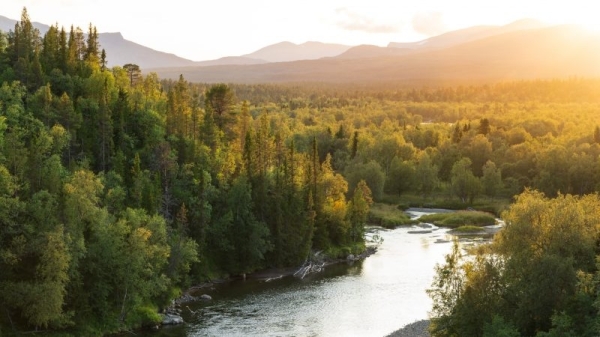Europe must protect its natural heritage in the North

Ahead of a meeting of forest directors on 16 May, hosted by the Swedish EU Council Presidency, campaigners have launched an appeal to implement an immediate logging moratorium in all forests with identified conservation values, including those in the North.
Human-induced climate change, loss of biodiversity and weakened ecosystems are now threatening the foundations of our civilisations.
Policy decisions made in the next few years will be critical. Halting the destruction and fragmentation of forest ecosystems as well as restoring and protecting the world’s forests is fundamental; not least for strengthening the resilience of ecosystems during a period when the climate gets increasingly extreme.
In a time when reduction of emissions and safeguarding every possible carbon sink and carbon storage is critical, Swedish forestry continuously moves large amounts of carbon out of the forests and into the atmosphere: prevailing logging methods cause large greenhouse gas emissions and research shows that reduced logging levels would provide large climate benefits in the coming decades.
Sweden harbours an important part of the EU’s natural heritage
The Swedish forest landscape is diverse and contains several areas of habitat types protected under the Habitats Directive, many of which are still unprotected, from the Western taiga with primary and old-growth forests and naturally regenerated continuity forests to the Fennoscandian hemiboreal natural old broad-leaved deciduous– and beech forests.
The Scandinavian Mountains Green Belt, largely situated within the borders of Sweden, is a unique natural heritage from a European as well as an international perspective.
The unprotected forests with high conservation values in Sweden are critical to maintaining biodiversity, protecting ecosystem functions and contributing to climate change mitigation.
In the north, the Sámi culture, including reindeer husbandry, is dependent on the forest for their livelihoods.
One of the major threats to Sámi culture is the loss of habitat due to direct or indirect impacts from competing land use, such as commercial forestry.
The forest provides shelter and relief for the reindeers from heat and insects, as well as food and materials for Sámi handicrafts.
Especially the ongoing clear-cut forestry aggravates the condition for reindeer husbandry by destroying habitats for tree-living beard lichens which is the second most important food resource for the reindeer.
Forestry methods such as soil scarification and the use of fertilisers also have a large negative impact on the ground lichens, the primary food resource for the reindeer.
During a period of 60 years the lichen-abundant forest land in the Swedish boreal landscape has declined by 70 %.
The right to Free, prior and informed consent (FPIC) by the Sámi people is a prerequisite to ensure respectful harvest conditions that protect traditional subsistence living but also biodiversity and ecosystems.
An in-depth assessment by the Swedish Forest Agency, of the environmental quality objective pertaining to forests shows an unsatisfactory ecological condition.
It concludes that in recent years, despite efforts to improve the ecological status of forest ecosystems, the trend is negative.
Moreover, 14 of 15 forest habitats listed under the Habitats Directive do not have a favourable conservation status. About 2000 forest-dwelling species are red-listed.
To conclude, most measures of the state of the forest ecosystem depict an alarming situation for biodiversity and ecosystem health in Sweden.
Despite the dire situation for the forest, the Swedish government that was installed last year, sharply reduced the budget for protection of nature with high conservation values as well as dismantled many climate initiatives.
Meanwhile, lobbying from the Swedish forest industry and the government is aggressive and scientists warn that “Sweden threatens European biodiversity” as they threaten to weaken or stop important legislative initiatives at the EU level.
It is clear that Sweden is fighting to defend “The Swedish Forestry Model”, with clear cuts as the predominant method.
This raises concerns that the urgent need for tackling the nature crisis in general, and specifically the forest ecosystem, will not be adequately addressed.
The urgency of the situation should not be underestimated
With today’s rapid logging rate, scenarios and estimates made by researchers, authorities and experts indicate that most of the remaining continuity forests and conservation values forests, outside nature conservation areas, will be lost within approximately one to a few decades.
We need healthy ecosystems to safeguard the fundamental conditions of our societies. We must preserve what’s left and restore what’s damaged. The appeal summarises the necessary steps:
- Implement an immediate logging moratorium in all forests with identified conservation values.
- Protect and restore forests in line with EU species and habitats directives, biodiversity- and forest strategy and the CBD-framework by 2030.
- Protect the Scandinavian Mountains Green Belt.
- Transform forestry to a close-to-nature management model.
- Constrain wood use within planetary boundaries.
- Áslat Holmberg, president of the Saami Council/Sámiráđđi
- Ulf von Sydow, Spokesperson at Protect the Forest Sweden
- Greta Thunberg, Fridays For Future Sweden
- Kelsey Perlman, European Forest Campaigner at Fern
- Andreas Nestor, Swedish Environmental Association of Law
- Erika Bjureby, head of Greenpeace Sweden
- Esmeralda Sjögren, Aurora



